
International Research Journal of Engineering and Technology (IRJET) e-ISSN: 2395-0056
Volume: 12 Issue: 01 | Jan 2025 www.irjet.net p-ISSN: 2395-0072


International Research Journal of Engineering and Technology (IRJET) e-ISSN: 2395-0056
Volume: 12 Issue: 01 | Jan 2025 www.irjet.net p-ISSN: 2395-0072
Dr. S. Brindha*1,Ms. T. Rajeshwari*2 , Mr. N. Balaji*3 , Mr. G. Cyril Samson*4
Mr. PL. Krithick*5 , Mr. k. Gokul*6
*1Head Of The Department, Department Of Computer Networking, PSG Polytechnic, Coimbatore, India. *2Lecturer, Department Of Computer Networking, PSG Polytechnic College, Coimbatore, India. *3,4,5,6UG Students, Department Of Computer Networking, PSG Polytechnic College, Coimbatore, India. ***
Abstract:
Delhi, the capital city of India, is one of the most polluted cities in the world, with air pollution levels frequently exceeding safe limits set by global health organizations. Major sources of air pollution in Delhi include vehicular emissions, industrial activities, construction dust, biomass burning and seasonal weather conditions like thermal inversions. Effective air quality monitoring systems play a pivotal role in addressing this challenge by providing real-time data and analyzing the concentration of pollutants in the atmosphere. Advanced technologies, such as IoT- and sending data to the cloud serverviatheinternet.This abstracthighlightsthecritical role of air quality monitoring systems in developing informed mitigation strategies, raising public awareness, based sensors enhance the accuracy and accessibility of airqualitydataandprovidereal-timedataandsupporting policymaking to reduce pollution levels and improve environmental and human health. Cleaner air enhances overallqualityoflifeandincreaseslifeexpectancy. These systems leverage advanced sensing technologies, IoT connectivity, and data analytics to provide real-time insights into air quality, identify pollution sources, and evaluate compliance with environmental standards. This abstract underscores the comprehensive advantages of combating air pollution, highlighting the importance of collaborative efforts among governments, industries, and communities to achieve cleaner air and a healthier, more sustainable future. All sensor readings for each post are displayed on the app, and alerts are sent via SMS and the app.
Key Words: The Internet of things, Air pollution, Realtime Tracking, Air quality monitoring, Environmental health.
Air pollution is one of the major problems in Delhi, the capitalcityofIndia.Ithasbecomeasevereandpersistent environmental and public health crisis. During the winter season it has experienced some of the highest level of air pollution in the world. As a result, residents of Delhi face elevated risks of respiratory diseases, cardiovascular issues, and other health problems. In environmental view
residents of Delhi face reduced visibility while driving whichhasledtofrequentaccidents;italsocausesdamage to ecosystems. It also causes economic impact like loss of productivity, healthcare costs, tourism decline, increased energy costs, agriculture losses. Air pollution in Delhi is driven by a variety of factors both natural and humanmade like vehicular emissions, industrial pollution, construction dust, crop burning in neighboring states, construction of new infrastructure, use of firecrackers, burning of biomass, weather and geographical factors, wasteburning,householdemissionThispaperpresentsan IOTbasedsolutionwhichcollectsdatathroughsensors.In thisweuseIoTsensorstomonitorairpollutioninthecity, it detects the impurities in air and collects data. Reducing airpollutionhelpstoincreasethequalityoflife.
This paper presents an IOT-based solution that is expected to automate air pollution. The system uses IoT sensors to monitor environmental parameters such as temperature, humidity, and air quality in real time. By automating theseprocesses, thesystem will helpincrease air quality monitoring system. Improves cleaner air and a healthierlife,moresustainablefuture.
The first aspect of this system is the real-time monitoring of environmental conditions such as temperature, humidity and air quality. Sensors installed throughouttheurban,rural,andindustrialareastoensure environmental and public health safety continuously monitor these parameters. and sent to the central processingunitforairqualityGassensorsuseharmfulgas emissions such as ammonia (NH3), carbon dioxide (CO2), and methane (CH4) benzene (C₆H₆), alcohol (C₂H₅OH), smoke, and other Volatile Organic Compounds (VOCs), theseGascanbesensedbythesensor
The information is reflected on a dashboard where the data can view in real time. If any environmental factors exceed a predetermined threshold an alert will be generated.

International Research Journal of Engineering and Technology (IRJET) e-ISSN: 2395-0056
Volume: 12 Issue: 01 | Jan 2025 www.irjet.net p-ISSN: 2395-0072
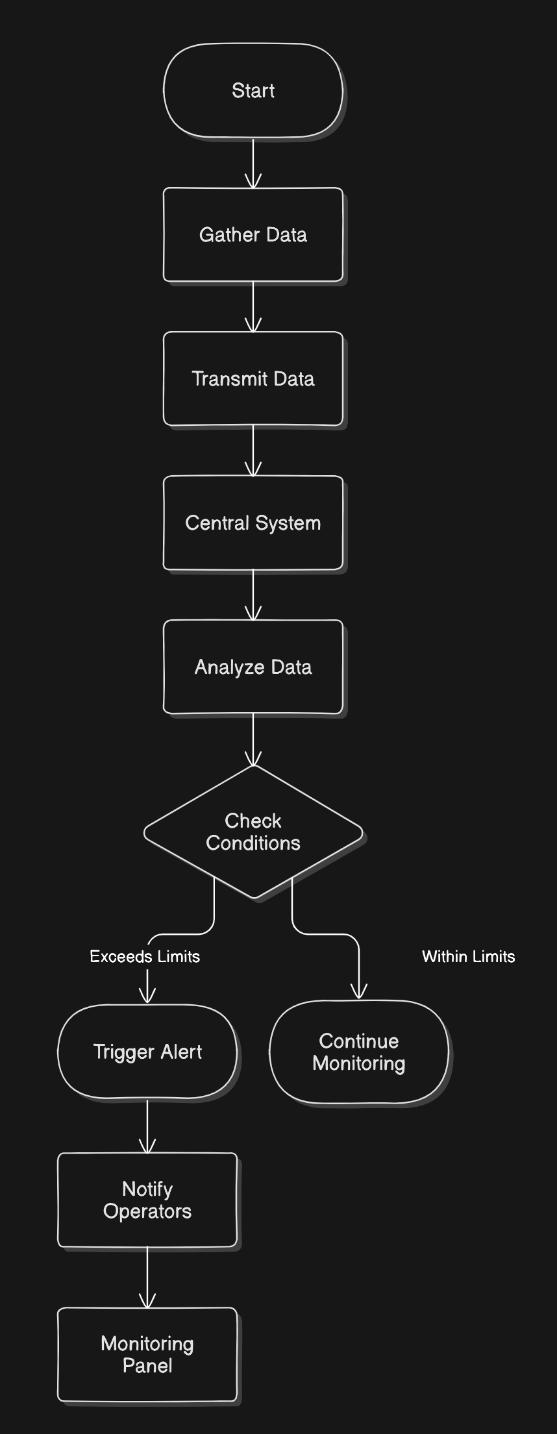
1. The sensor collects temperature, humidity and gas concentration.
2. Data will be sent to a central system for analysis and tracking.
3. An alert will be issued if conditions exceed the ideal limit
This part of the system involves developing a mobile application that allows operators to remotely monitortheirenvironment.Themobileapplicationserves as a user to manage interface that provides real-time information. It allows users to track environmental parameters,andreceivealertsfromthesystem.Operators canadjustsettingssuchashumidity,temperatureandgas value.Evenifit’soutsidethelocation.Theapplicationalso stores historical data to enable trend analysis and better
long-term decision making for air pollution. Mobile app resources:
Real-time monitoring: Displays temperature, humidity andairqualityinformation.
Control: Turn specific sensors on or off based on need, remotelyadjustsensorsensitivitytomaintainaccuracy.
Alert system: Immediate notification when limits are violated.
Data Log: Historylogfordataanalysisandreporting.
The system architecture is designed to ensure efficientcommunicationandreal-timeprocessingbetween IOT sensors, central processing units, and mobile applications. and dice storage in the cloud Each component plays an important role in the collection, transmission, storage and display of data to support or automatethemanagementoftheairpollution.
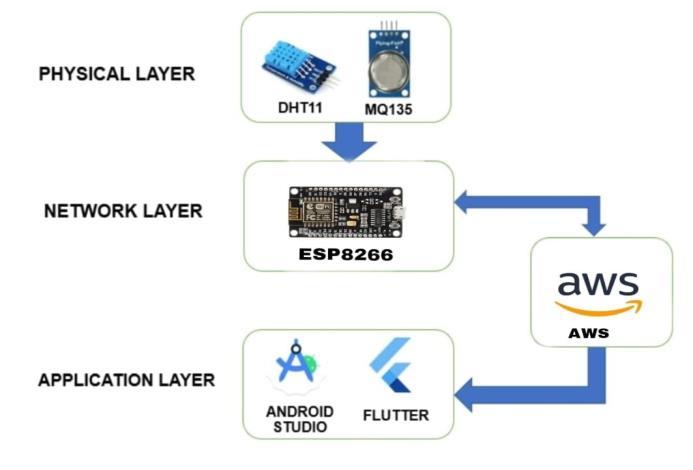
The AIOT system relies on multiple sensors embedded to continuously monitor environmental parameters.Thesesensorsinclude:
Temperature sensor: Atemperature sensorin anair quality monitoring systemhelps track environmental conditions that influence pollutant behavior and sensor accuracy. It measures air temperature, which affects how pollutants spread and concentrate. For example, higher temperatures can increase ozone levels or smog formation.

International Research Journal of Engineering and Technology (IRJET) e-ISSN: 2395-0056
Volume: 12 Issue: 01 | Jan 2025 www.irjet.net p-ISSN: 2395-0072
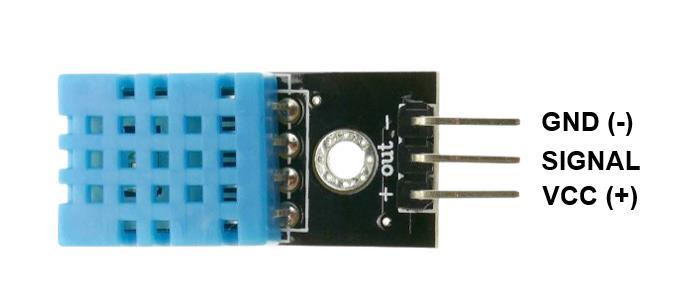
Humidity Sensors: Humidity sensors in air quality monitoring systems help track moisture levels in the air, whichaffectpollutantbehaviorandsensoraccuracy.High or low humidity can influence the size of particulate matter, chemical reactions, and the formation of smog, impactingairquality.
Gas Sensor: Gas sensors like electrochemical, semiconductor, infrared, and optical sensors are used in air pollution monitoring systems to detect harmful gases (e.g.,CO,NO₂,VOCs)andparticulatematter. Theyprovide real-time data for urban, industrial, and environmental applications.Gassensorsforairqualitymonitoringdetect variousharmfulgasesandpollutantsintheair.
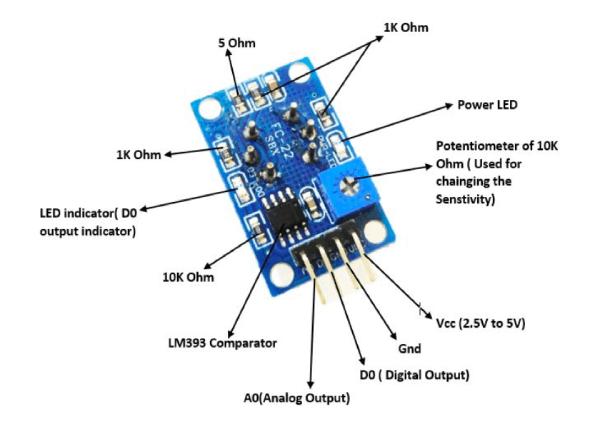
Thebrainofthesystemhardwareisthemicrocontroller. It processes data collected from IoT sensors for this project. ESP8266 or Arduino microcontrollers are used because of their flexibility. Low power consumption and the ability to read with multiple sensors simultaneously. The microcontroller collects real-time data from two sensorsandsendsitto
Sendnotificationstoamobiledeviceasitfollowsthe followingsteps:
Data collection: Thesensorcollectsenvironmentaldata (suchastemperature,humidity,gasconcentration).
Software and Programming: Programming Environment:UsetheArduinoIDEforeasyprogramming andcontrolovertheESP8266.
Data transmission: Using the Wi-Fi module integrated into the microcontroller. The processed data will be sent todatabank(Blynk)forlaterstorageandanalysis.
Data Processing: The microcontroller processes the raw sensordataandconvertitvision.
Web Dashboard: The system can be connected to a mobile app or a web-based dashboard, where users can monitorreal-timedataandreceivealertsaboutairquality.
Email or SMS Alerts: The system can send real-time alertsviaemailorSMSwhentheairqualitycrossescritical thresholds. This helps users take immediate actions, like ventilatingaroomorturningonairpurifiers.
The wireless communication system for air pollution monitoring involves the use of wireless sensors and communication technologies to detect, collect, and transmitairqualitydatainthecity.Airqualitysensorsare installed in different locations of the city to measure pollutantsandcollectdata continuously.Sensorssendthe data to the cloud platform using cellular networks, Wi-Fi, or LPWAN. This data can be accessed by the authorities and public using the dashboard or apps. Wireless communication allows for automated alerts via mobile apps, websites, or SMS, informing residents about air quality levels. Wireless communication enables more effective and scalable air pollution monitoring, helping cities like Delhi tackle their pollution challenges in an efficientmanner.
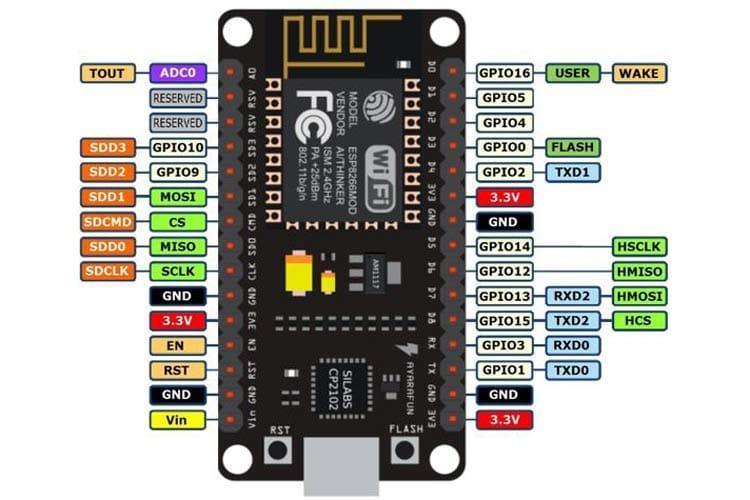
Amazon cloud storage service acts as a back-end data warehouse to store and manage sensor data This guarantees that the data collected from the sensors is

International Research Journal of Engineering and Technology (IRJET) e-ISSN: 2395-0056
Volume: 12 Issue: 01 | Jan 2025 www.irjet.net p-ISSN: 2395-0072
instantly updated in the mobile application. The main benefitsofusingAWSinclude:
Scalability: AWS scalability can be effectively applied to air pollution monitoring and management by enabling real-time data collection, processing, and analysis across large-scale environments. Systems can handle increasing usersandintegratemultipledevices.
Real-time updates: A real-time air pollution monitoring system powered by AWS provides continuous updates, enablingtimelyactionsand insights.Here’showreal-time updates can be implemented effectively and allowing operators to receive immediate updates whenever they exceedtheirlimits.Alimitorwarninghasoccurred.
Security and data management: criticalforairpollution monitoring systems to ensure data integrity, confidentiality,andcompliancewithregulatorystandards. Secures communication between air quality sensors and thecloudusingmutualTLSauthenticationandencryption (AES-256) This ensures that only authorized users can accessoreditthedata.
(e.g., smoke, industrial emissions). Share data with local authoritiesorcommunities.
Applications developed in Flutter serve as the main interface betweenfarmuser and the AIOTsystem.Flutter was chosen because of its ability to create multi-platform mobile applications. This makes it possible to use the system on Android and iOS devices with a single code base.Themainfunctionsoftheapplicationinclude:
Real-time monitoring: This app shows real-time temperature, humidity and gas levels. It is displayed throughgraphsandaneasy-to-readwebpageandprovide global,regional,orlocalairqualityreportsusingAPIs(e.g., OpenWeather,AirVisual).
Alarm system: Whenever environmental parameters exceed preset limits. The application will create a notification. To inform user of problems These notifications are sent via push notifications. Serious problemsareguaranteedimmediately.
Access historical data: The app stores historical data in aws, allowing users to analyze past trends and optimize farmconditionsovertime.
Data Visualization: Interactive maps showing pollution hotspots.
Community Reporting: Enable users to report pollution incidents
Designing an alerting system for air pollution monitoring involves setting up mechanisms to monitor air quality parameters and notifying relevant stakeholders when certainthresholdsareexceeded.
Real-Time Alerts: Send immediate notifications when pollutant levels exceed predefined thresholds like SMS, Email,PushNotifications.
Periodic Updates: Provideregularupdatesonairquality, evenifnothresholdsareexceededbyachannelslikeDaily emailsorappnotification,socialmediaupdates.
Escalation Alerts: Triggered for prolonged exposure to high pollution levels or when levels reach "Hazardous." Informlocalauthoritiesoremergencyresponseteams.
Public Warnings: Broaderalertsthroughpublicchannels duringsevereairqualitybyRadio/TVannouncementsand Sirensorpublicaddresssystems.
Mobile Apps: Provide real-time AQI data and alerts. Allowuserstosetcustomthresholdsfornotifications.
Web Dashboards: Visualize pollution data and alert statuses on interactive maps or charts. Allow access to historicaldataandtrends.
Wearable Devices: Smartwatches or fitness bands with AQI indicators. Vibrations or on-screen alerts for severe conditions.
Smart Home Devices: Trigger air purifiers or close ventilation systems automatically when pollution levels rise.
HVAC Systems: Automatically adjust settings based on indoorandoutdoorAQI.
Example Alert Message: "Unhealthy Air Quality Alert: PM2.5 level is 180 µg/m³ in Downtown. Avoid outdoor activities, especially for sensitive groups. Effective until 6 PM."
Sensor monitoring is the core of an air pollution monitoring system, as it involves collecting, processing, andanalyzingdataonairquality.
Sensor Placement and Deployment: Urban areas, Industrial Zones, Rural and Remote Areas, Indoor Monitoring.

International Research Journal of Engineering and Technology (IRJET) e-ISSN: 2395-0056
Volume: 12 Issue: 01 | Jan 2025 www.irjet.net p-ISSN: 2395-0072
Sensor Health Monitoring: Track the status of sensors. Use self-diagnostic features to identify malfunctioning units.
Spatial Mapping: Use GIS tools to map pollution levels across different areas. Deploy mobile sensors on vehicles fordynamicmonitoring.
User Interface and Reporting: Provide user-friendly dashboardsforstakeholders.Generateperiodicreportsto trackprogressandinformpolicydecisions.
Parameter Monitoring: Measure critical pollutants like PM2.5, PM10, CO, NOx, SO2, O3, and VOCs. Monitor auxiliary parameters such as temperature, humidity, and windspeedforbetterdatainterpretation.
5.1
Respiratory and Cardiovascular Diseases: Airpollution is a significant contributor to respiratory and cardiovascular diseases. Fine particulate matter (PM2.5), ozone (O₃), nitrogen oxides (NOx), and sulfur dioxide (SO₂) can penetrate deep into the lungs and bloodstream, leadingtoconditionssuchasasthma,bronchitis,andeven lungcancer.
Premature Mortality: The World Health Organization (WHO) estimates that air pollution is responsible for millions of premature deaths each year globally. Diseases linked to air pollution include stroke, heart disease, lung cancer, and chronic obstructive pulmonary disease (COPD).
Vulnerable Populations: Children, the elderly, and individuals with pre-existing conditions (e.g., asthma) are especially vulnerable to the adverse health impacts of air pollution.Prolongedexposuretopoorairqualitycanstunt lungdevelopmentinchildrenandaccelerateaginginolder adults.
Mental Health: Recent studies suggest that exposure to air pollution may also have negative effects on mental health, contributing to cognitive decline, depression, and anxiety.
5.2Environmental
Ecosystem Damage: Air pollution can disrupt ecosystems, harming vegetation and wildlife. Nitrogen oxides (NOx) and sulfur dioxide (SO₂) can contribute to acidrain,whichdamagessoil,waterbodies,andplantlife.
Reduced Agricultural Productivity: Air pollutants like ozone can affect crop yields, leading to lower food production. Studies have shown that ozone can reduce
photosynthesis in plants, particularly affecting sensitive cropslikewheat,rice,andcorn.
Climate Change: Some pollutants, like carbon dioxide (CO₂) and methane (CH₄), are greenhouse gases that contribute to global warming. Others, like black carbon (soot), contribute to the melting of glaciers and ice caps. Airpollutionandclimatechangeareinterlinked,creatinga viciouscycleofenvironmentaldegradation.
Healthcare Costs: The healthcare system bears a significant burden due to air pollution-related diseases. Treatment of respiratory diseases, heart conditions, and cancer requires substantial public and private healthcare expenditures.
Loss of Productivity: Poor air quality can reduce worker productivity due to illnesses, absenteeism, and early retirementfromchronichealthconditions.
Agricultural Losses: Thedamagetocropsandforestsdue to pollutants can lead to economic losses in agriculture, affecting food security and livelihoods, particularly in developingcountries.
Cost of Environmental Cleanup: Governments often need to invest in the restoration of ecosystems damaged by pollution, including cleaning up water bodies and soils affectedbyacidrain.
Transport: The burning of fossil fuels in vehicles is a major source of air pollution, emitting pollutants like carbon monoxide (CO), nitrogen oxides, and particulate matter.
Industry: Factories,powerplants,andrefineriesreleasea wide range of pollutants, including sulfur dioxide (SO₂), nitrogen oxides (NOx), and volatile organic compounds (VOCs),contributingtosmogandacidrain.
Agricultural Activities: Agriculture releases ammonia (NH₃)andmethane(CH₄),whicharepotentairpollutants. Livestock farming and the use of fertilizers are major contributorstoairpollution.
Household Activities: The burning of biomass (wood, crop waste, etc.) and household fuels (such as coal and kerosene) can generate indoor air pollution, which is a leading cause of respiratory diseases in developing regions.
Urban vs Rural Areas: Urban areas often face higher concentrations of air pollutants due to dense traffic and

International Research Journal of Engineering and Technology (IRJET) e-ISSN: 2395-0056
industrial activities, whereas rural areas may experience pollutionfromagriculturalpracticesandbiomassburning.
Regional and Global Transport of Pollutants: Air pollution is not confined to one location. Pollutants can travel long distances, crossing borders and affecting neighboring countries. This transboundary pollution requiresinternationalcooperationforeffectivemitigation.
Indoor Air Pollution: Indoor air pollution, often caused by cooking with solid fuels or using chemical-based products, is a major issue in many developing countries, where it can lead to severe health outcomes, especially amongwomenandchildren.
5.6 Solutions and Mitigation
Regulation and Legislation: Governments around the world have introduced various measures to reduce air pollution, including stricter emission standards, vehicle regulations, and air quality monitoring. The success of policieslike theCleanAirActintheUnitedStatesandthe European Union’s air quality standards demonstrates the potentialofregulation.
Renewable Energy Transition: Switching to renewable energy sources (solar, wind, hydroelectric) can significantly reduce the emissions from fossil fuels, mitigatingairpollutionanditsassociatedimpacts.
Cleaner Transportation: Promoting electric vehicles, improving fuel efficiency, and expanding public transportation options can help reduce air pollution from thetransportsector.
Green Urban Planning: Urban planning that includes greenspaces,treeplanting,andreducedtrafficcongestion canhelpimproveairqualityincities,absorbingpollutants andprovidingcleanerair.
Public Awareness and Education: Raising awareness about the sources and impacts of air pollution can encourage individuals and industries to reduce emissions andadoptmoresustainablepractices.
Technological Innovations: Advances in pollution control technologies, such as filters and scrubbers, can help reduce the emissions from industrial processes and powerplants.
5.7
Delhi, India: One of the most polluted cities globally, Delhi has implemented various measures, including vehicle restrictions and promoting electric vehicles, to addressairpollution.
Beijing, China: China’s efforts to curb air pollution have included stricter environmental policies and a shift
towards cleaner industrial practices, though challenges remaininruralareasandindustry.
Los Angeles, USA: As one of the cities with the most stringent air quality standards, Los Angeles has improved airqualityoverthedecades throughregulationstargeting emissionsfromvehiclesandindustrialactivities.
Herearesampleoflastyearairqualitydata:
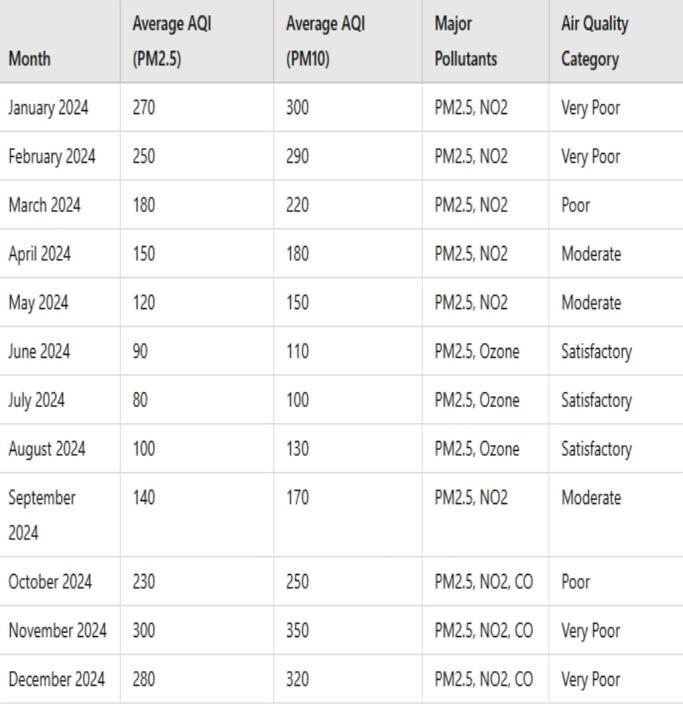
To effectively control an air pollution monitoring system, it's essential to ensure the system is not just monitoringbutactivelyaidinginreducingpollutionlevels.
Calibration and Maintenance: Regular calibration of sensorstoensureaccuracy.Periodicmaintenancetoavoid sensordriftandfailures.
Real-Time Alerts and Automated Actions: Develop threshold-based triggers for pollution levels. Automate control actions, such as activating air purifiers or informingauthorities.
Quality Assurance/Quality control (QA/QC): Establish standard operating procedures (SOPs) for data collection Cross-check data with reference-grade instruments for qualityassurance.
Redundancy: Deploymultiplesensorsincriticallocations to reduce the risk of data loss or inaccuracies. Integrate data from overlapping sensor networks for enhanced reliability.
Volume: 12 Issue: 01 | Jan 2025 www.irjet.net p-ISSN: 2395-0072 © 2025, IRJET | Impact Factor value: 8.315 | ISO 9001:2008

International Research Journal of Engineering and Technology (IRJET) e-ISSN: 2395-0056
Volume: 12 Issue: 01 | Jan 2025 www.irjet.net p-ISSN: 2395-0072
IOT-based systems are deployed in a air pollution monitoringsystemandfoundseveralimportantresults:
Monitoring Accuracy:The system accurately tracks temperature,humidityandgaslevels.Itprovidesreal-time informationtoagriculturaloperators.
Alert system: Alerts are issued immediately when environmental limits are exceeded. This allows for quick correctiveaction.
Firebase Integration: Using AWS Firebase allows realtime data synchronization and storage. This ensures that operatorshaveaccesstothelatestinformationatalltimes. These observations demonstrate the effectiveness of the IOT system in improving pollution survey management throughautomaticmonitoringandcontrol.
User Engagement: High adoption rates for mobile apps with features like live AQI maps, notifications, and health recommendations. Personalized alerts were particularly effective for users in high-risk groups. Increased awarenessaboutairpollutionamongusers.
System Efficiency: IoT-enabled devices provided realtime updates with minimal latency. Cloud integration ensured scalable data handling and processing. Cloud integrationensuredscalabledatahandlingandprocessing.
Environmental and Health Impact: Communities used the data to address pollution sources. Real-time alerts helped reduce healthincidentsrelated topoorairquality. Reducedexposuretopollutantsforappusers,contributing tobetterpublichealthoutcomes.
Cleaner air enhances overall quality of life and increases life expectancy. Environmental benefits include the restoration of ecosystems, improved biodiversity, and reducedgreenhousegasemissions,whichmitigateclimate change. Economically, addressing air pollution fosters innovation in clean technologies, creates green jobs, and enhances productivity by reducing pollution-related workforce absenteeism. Reducing air pollution in Delhi wouldnotonlyimprovethequalityoflifeforitsresidents but also contribute to broader environmental and global goals. Theimpactwouldripplethroughpublichealth,the economy, and the overall sustainability of the city. Reducing air pollution would significantly enhance the health, well-being, and quality of life for Delhi residents, creating a cleaner, safer, and more equitable urban environment. Furthermore, it promotes sustainable urban development and compliance with international environmentalstandards.
The IOT system's modular design allows for future improvements,including:
AI in Real-Time Data Analysis: AI-powered analysis enables real-time data processing from multiple sensors and devices, offering accurate air quality readings. Automatedanomalydetectionhelpsidentifysensorerrors orenvironmentalfactorsaffectingdataaccuracy.
AI-Personalized Health Alerts: AIcansendpersonalized notifications to users (eg, individuals with asthma) based ontheirhealthprofiles,pollutionlevels,andlocation.
AI-Pollution Source Detection: It identifies sources of pollutionbyanalyzing patternsinairqualitydatabyhigh levelsofairpollutionareas.
AI-Predictive Analytics: AI algorithms forecast pollution levelsbasedonhistoricalandreal-timedata,offeringearly warningsforhigh-pollutionevents.
Integration with IoT: AI-enabled IoT devices (smart sensors, air purifiers, HVAC systems) can collaborate autonomously. When high pollution is detected, the system can automatically notify individuals, trigger air purifiers, or adjust ventilation systems in homes, workplaces,andpublicspacestoreduceexposure.
Blockchain integration: to guarantee transparency and traceability of data. Future versions of the system may incorporateblockchaintechnologyforsecuredatastorage and sharing. This increases the reliability of agricultural operations and provides valuable information on agriculturalmanagementpractices.
The introduction of IOT-based air pollution monitoring system has shown significant potential for improving human welfare.The system's ability to continuously monitoritsenvironment.Managenotificationsinrealtime and provide remote access through mobile applications. Theairpollutionmonitoringsystemisanessentialtoolfor improving environmental health and achieving sustainable urban and industrial growth. It provides realtime data to track pollutant levels, informs policy decisions, and raises public awareness. While technological advancements improve accuracy and efficiency, challenges like data coverage and system maintenance remain. Ultimately, air pollution monitoring system is key are to achieving cleaner air, supporting sustainable development, and mitigating the harmful effectsofpollution.
IOT systems are a promising approach to sustainable and efficientairpollution.Itsscalabilityandadaptabilitymake

International Research Journal of Engineering and Technology (IRJET) e-ISSN: 2395-0056
Volume: 12 Issue: 01 | Jan 2025 www.irjet.net p-ISSN: 2395-0072
it suitable for air pollution. By providing real-time data, they help inform policies, raise awareness, and guide actionstoreducepollution.Airqualitymonitoringsystems contribute to better environmental policies, healthier communities,andmoreinformeddecision-making.
[1] Sitaram, K.A., Ankush, K.R., Anant, K.N., & Raghunath, B.R., (2018). IoT based smart management of poultry farm and electricity generation. In IEEE International Conference on Computational Intelligence and Computing Research (ICCIC), 1-4. IEEE. https://doi.org/10.1109/ICCIC.2018.8782308. M. Young, The Technical Writer’s Handbook. Mill Valley, CA:UniversityScience,1989.
[2] G. Katare, G. Padihar, and Z. Qureshi, “Challenges in theintegrationofartificialintelligenceandinternetof things,” International Journal of System and Software Engineering,Vol.6,No.2,pp.10–15,2018.
[3] U.N. D, U. S, L. Tamilselvan, and S.N. J, “Client Aware Scalable Cloudlet to Augment Edge Computing with MobileCloudMigrationService,”InternationalJournal ofInteractiveMobileTechnologies(iJIM),Vol.14,No. 12,pp.165–178,2020.
[4] Y. Zhang, Q. Chen, G. Liu, W. Shen, and G. Wang, “Environment parameters control based on wireless sensor network in livestock buildings,” International JournalofDistributedSensorNetworks,No.5,pp.1–7, 2016.
[5] ] J. Kalezhi, J. Mbale, and L. Ndovi, “Microcontrollerbased monitoring and controlling of environmental conditions in farming,” 2018 IEEE PES/IAS PowerAfrica,pp.284–288,June,2018.
[6] B.Lufyagila,D.Machuve,andT.Clemen,“IoT-powered system for environmental condi tions monitoring in poultry house: A case of Tanzania,” African Journal of ScienceTechnologyInnovationandDevelopment,Vol. 14,No.12,pp.1–12,2021.
[7] Dr. S.Brindha, Ms.T. Rajeshwari,Ms. Braj Kaviya A.T, Ms. T. Durga Priyadarshini, Ms. V. Samaya, “Data Analytics And Machine Learning In Intelligent Nutrition Systems: Transforming Health And Wellness” International Research Journal of Modernization in Engineering Technology and Science,Volume:06/Issue:01/Jauuary-2024
2025, IRJET | Impact Factor value: 8.315 |